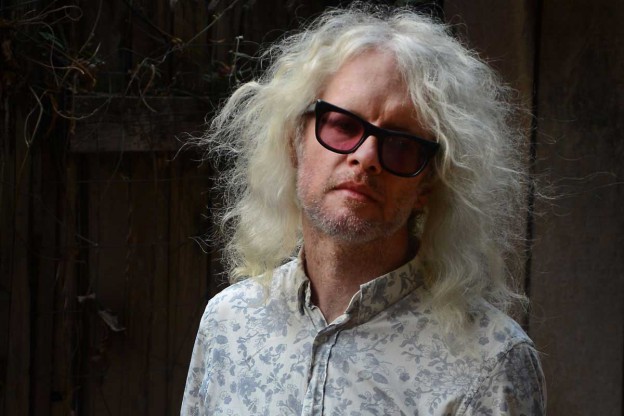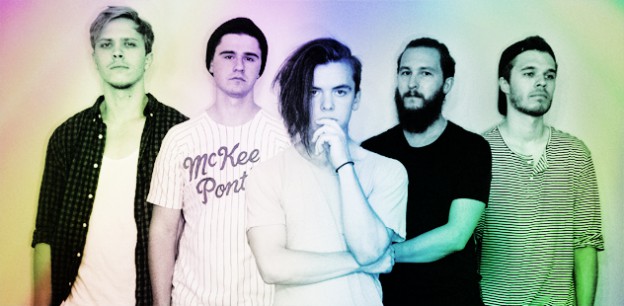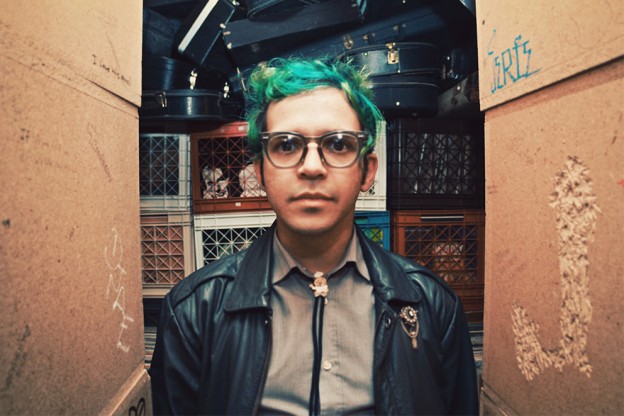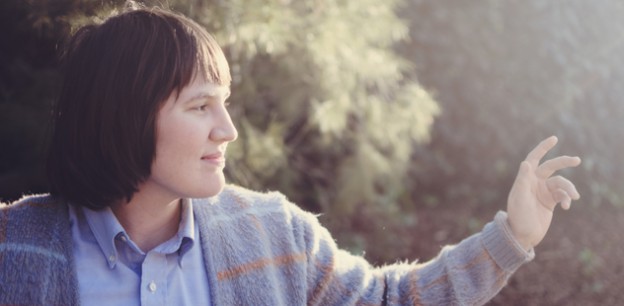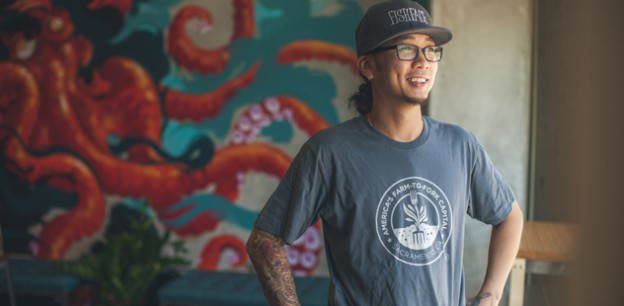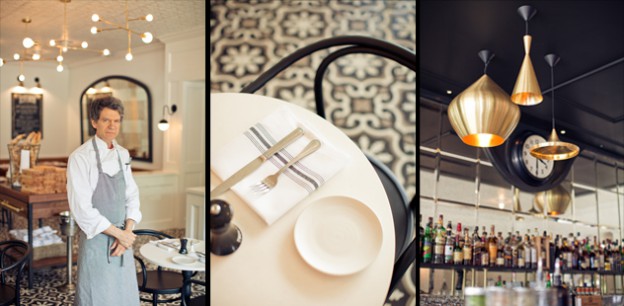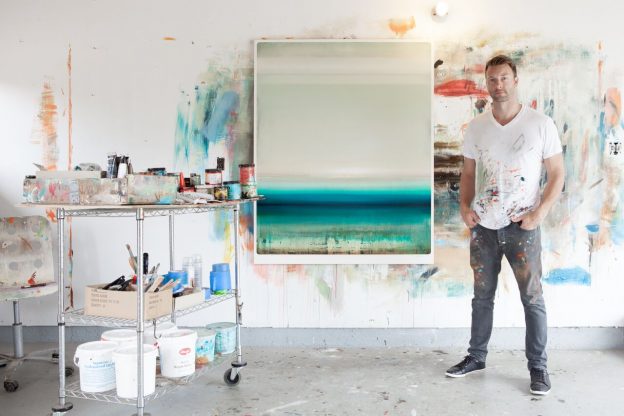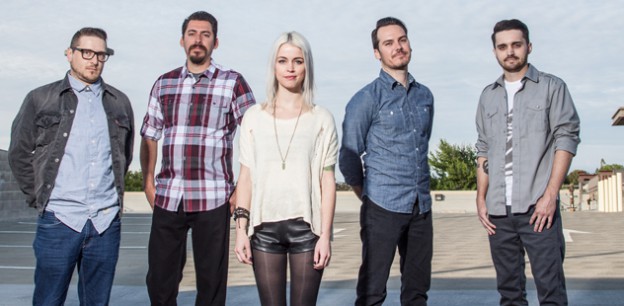Into the Light
Dynamic duos are usually associated with comic books or television superheroes that join forces in order to save the day; the Wonder Twins and Saturday Night Live’s Ace and Gary instantly come to mind. Typically, these duos eke out an existence lurking in the shadows in some metropolitan city where they carry out amazing acts of heroism. Sacramento has its own version of a heroic twosome, but instead of battling bad guys, muralists Sofia Lacin and Hennessy Christophel swoop in with their paint brushes and vibrant hues to transform outdoor spaces from the outside in.
The two artists met while attending Mira Loma High School and reconnected shortly after college, eventually forming their own design business LC Studio Tutto and embarking on their first large-scale art project when they were invited to be a part of the 1409 R Street block transformation.
“That was kind of our first taste of being a part of something that totally transformed a place and as we started working in public. We got kind of hooked on that feeling of being able to create things that were really having an impact on people and touching people’s daily lives and experiences,” Christophel explains.

Lacin and Christophel are driven by this concept of connecting their work with the daily lives of those who move through the city. The art duo’s creativity thrives in urban spaces that have been either forgotten or left to wither in blight by reimagining and enriching each space through color and form to uncover the beauty and identity that wasn’t there before. Each credit their varied artistic backgrounds as the reason why their partnership works so well.
“Sofia and I feel like we have this great balance that happens between us,” Christophel says. “I have a very kind of micro perspective, and she has a kind of bigger picture perspective and is a lot more focused on color, so I think they’re very different backgrounds that we have, different skills, but they complement each other very well.”
Lately, the subject of public art in Sacramento has been at the forefront of just about every discussion involving the future of the city—from the grumblings over the millions of dollars being thrown in the direction of artist Jeff Koons to erect an artist offering to complement the highly contentious new downtown arena, to the simple discussion of what role should public art play in this cultural renaissance of Sacramento. Lacin and Hennessy’s latest creative undertaking, the Bright Underbelly project, serves as a reminder of why public art is vital to a city’s identity and character.
“The most powerful part of public art is that the space is not curated it’s out in the open, anyone can pass through,” Lacin says. “I think if you really pay attention to the site and the community, you are able to add elements in the design that resonate with anyone in that community. It becomes like this surprising little mirror of that culture, and I think that’s one of my favorite things. It’s out there in the open for anyone to experience.”
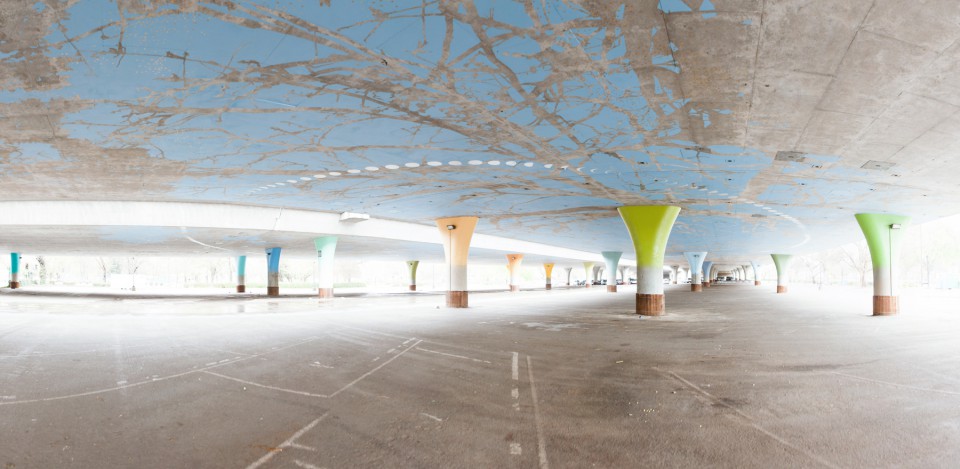
As the two celebrate a decade of working together, this dynamic duo have 70 installations under their belts that include the We’re All In It Together mural on Midtown’s BloodSource building; a mural and sculptural installation for The Mill at Broadway, a new urban housing community in Sacramento; as well as Hanging Mist an installation made up of 72 perforated aluminum panels painted in soft layers of color, forming two walls of the inner courtyard of Warehouse Artists Lofts. But it’s their ability to create a career out of their shared artistic passion that the two are really proud of.
“I was also lucky enough to grow up with creative parents, they run a business together, a professional photography studio,” Lacin explains. “So I kind of grew up with this, not only this model of creativity and how that is a valuable thing to contribute to the world but also, how do you make that your job, your full-time job. So, I have kind of done my best to make art a career for us and I just believe that I could never do anything else.”
While Lacin and Christophel are no strangers to creating larger-than-life art installations—they’re responsible for adorning a 4 million-gallon water tower in Davis they call Same Sun, which features shadows cast by sculptures moving against a radiant, golden-hued background—Bright Underbelly, a mural covering 70,000 square-feet and celebrating the seasons will hover above the city’s largest farmer’s market under the Highway 50 overpass at Eighth and W streets. It will be the largest project the twosome have tackled to date. After five months of lying on scissor lifts, kicking back on yellow lawn chairs procured from the streets of Midtown, it’s most certainly their most backbreaking project too.
“We’ve been in these chairs, lying down like freaks for five months under this freeway,” Lacin chuckles. “One of the weirdest parts about it, I couldn’t believe how exhausted I was. I was like ‘I’m lying down; this is going to be cool. I’m not going to be tired, I’m going to go party after.’ It was exhausting like driving for 12 hours is. You’re very focused, and it’s also a very isolated experience. To be two inches from the belly of the freeway that trembles as big rigs drive overhead.”

The inspiration for the project came from Bright Underbelly project manager Tre Borden after a trip to Buenos Aires, Argentina. Borden, who is no stranger to the arts community after managing projects at Exhibit S gallery in the former Downtown Plaza and running the Flywheel artist incubator in 2012, says that this project is just what the community needs.
“I saw this pedestrian bridge that had been beautifully muraled as a way to kind of create a gateway into the arts and culture district and I thought, ‘Wow, we have so much stuff like that here that’s kind of just languishing so why don’t we do that?’” Borden explains. “We thought to prove our point, let’s pick the place that’s most visible where our farm-to-fork identity was really born and it’s also a really great location in terms of how it connects so many different communities.”
When the ribbon cutting ceremony takes place March 17, the underbelly of the freeway will have undergone a complete transformation celebrating the natural world that surrounds us, including a shimmering rendering of the lunar cycle. The artists say that the project wasn’t erected on an island, but was forged out of a true collaboration between the artists, city stakeholders and, most importantly Borden says, the executives at the California Department of Transportation.
“I love that there’s all this activity above. In the summertime, the market has like 10,000 people, there’s all this activity below and then the mural exists in this kind of quiet space in between,” Christsophel says. “You don’t look at it so much as you move through it and experience it. We decided we wanted to have it be this kind of journey through the seasons that people experience as they walk through because the seasonality of the agriculture, the produce that fills the market every Sunday connecting that to the big picture of these natural cycles that we live in, that was our vision for the space.”
In true dynamic duo fashion, Lacin and Christophel seek to make an impact on the world around them. They thrive in collaborative environments by creating large-scale public art installations that bring life and identity into spaces that would otherwise go unnoticed to inspire a connection between people and their surroundings.
“I love the ability to go into any environment and bring life through color, I’m inspired by that idea and I strive to do that,” Lacin says.
You’ll have multiple opportunities to enjoy the unveiling of Lacin and Christophel’s new mural: A ribbon cutting ceremony on March 17 from 9–10 a.m. (free); from 11 a.m.–2 p.m. on March 19, Bright Underbelly will host a family-friendly affair featuring food trucks, a scavenger hunt and a lecture from Lacin and Christophel (also free); Spring Awakening: An Art and Food Experience will take place on March 20 from 5–9 p.m. and will allow you to dine beneath the mural and sample a limited edition Bright Underbelly beer from New Helvetia. The latter event will also feature live music and a special menu created by Chef Patrick Mulvaney. For more info, go to Brightunderbelly.com
Magic Man
When your uncle is a professional magician and bestows upon you his magic kit after hanging up his top hat, it’s only natural that your first gig as a performer involves magic. For the quintessential Sacramento musician, Anton Barbeau, this is exactly how he first landed on the stage and caught the performance bug.
“My first performance, my first gig, was doing magic in school—I was 10 or something like that. As a magician I was probably reasonably mediocre but I loved performing, so that was my beginning as a performer was doing magic,” he chuckles.
While Barbeau didn’t take his magic act to Las Vegas, his need to create magic never abated. Instead, the artist plunged headfirst into the local musical pond and has been swimming there ever since. To say that the singer, songwriter and multi-instrumentalist’s work is prolific would be a gross understatement. Come on, the guy has put out more than 20 recordings in the last 20 years—some years putting out as many as three albums during a single trip around the sun. But his latest musical effort might just prove to the world that his work is truly magical.
Collaborating via the Internet and email, artists from across the globe contributed to the musical process of creating Magic Act without setting foot into the studio with Barbeau. The process was one in which Barbeau himself didn’t necessarily think would pan out into musical gold, but the end results even surprised him.
“Tracks were coming in from Italy and Spain and all over the world. It’s kind of exciting because it all fit together—it does work, which surprises me,” he explains. “I always like the feeling of having a band or people that you’re in the same room with and there’s the chemistry but in this case some of the chemistry seemed to happen from around the globe, electronically and it still fits.”
As a born-and-bred Sacramento artist, Barbeau’s local roots are deep—as the prodigal son of the local music scene his artistic presence still resonates. And while he calls Berlin home now, he makes a concerted effort to return to those roots, often finding himself back in his room at his father’s house toying around with new ideas on his old drum kit and other instruments laying around before heading out to reconnect with friends, family and old bandmates.
“It’s funny because I’ve been back recently, and so I’m hoping the prodigal son shtick still works. I’ve got a really good band in Sacramento and it’s really fun playing with these guys,” he says. “To be playing songs off of the new record will be good—I do feel appreciated when I’m back, in California in general, it’s nice to come home. There are people who know my catalog, there are people who know songs of mine from 10,000 years ago. There’s something gratifying in that.”
Currently, the magician-turned-musician is gearing up to make his way back home with his bag of tricks in tow to play once again for the hometown crowd with a smattering of performances throughout the area with gigs at Luna’s Café and Fox and Goose, but it’s the record release party at Shine on March 12 to celebrate Magic Act that Barbeau is really looking forward to.
“I think the songs are sort of a typical range from me, there’s a handful of the three-minute pop songs with catchy choruses but there’s also sort of a murky, psychedelic middle [section] and I feel it’s a very genuine record for me,” he explains.
The record—much like the artists who collaborated on it from all over the globe—is a collection of songs and ideas that coalesced magically. Some of the pieces of music that landed on the album started out as tracks for other records and some were just sitting on the shelf, collecting dust in Barbeau’s seemingly infinite catalogue of music.
“I’ve made a lot of records and it’s easy, it’s what I do. So with this one, it feels like the songs picked themselves, they chose to be together,” he explains. “It feels like they belong with the rest of the songs. It’s not often that I make albums where I feel like the album itself tells me what to do. When that happens there’s something magical about that which is nice considering it’s called Magic Act.”
Certainly Barbeau’s long-spanning career is proof of his incredible drive and devotion to making music. He’s been making music longer than most of the hottest local bands have been jamming. His music is a powerful mix of pop and psychedelic but it also takes cues from The Beatles and David Bowie. Sure, he’s been bestowed with considerable praise from establishments like the BBC and Spin magazine, and is pretty much beloved by everyone when he comes home to play shows. But even a celebrated artist can appreciate those special moments where the process of making music is truly transcendent.
“Most of the people on this album are people who I’ve worked with before … but a few people [aren’t], like Colin Moulding from XTC. You know, XTC are huge, huge heroes of mine,” he gushes. “To work with Colin was a really thrilling moment—and again that’s a kind of magic, to work with one’s heroes.”
For Barbeau it really is all about the work. From his sanctuary in Berlin, where he spends the majority of his time dreaming up new material, to the frenetic and inspiring energy of the streets and canals that litter the cultural and artistic center of Germany, the mercurial musician is always at work. It’s the only thing he knows how to do, he admits.
“When it really works on another level for me is when things sort of spring out of nowhere or somewhere where you can’t see,” Barbeau says. “I think with this record it feels like that happens a lot, everything feels really inspired even when tracks were sent across the globe through email everything fit. One musician is responding to another musician’s performance, even if they aren’t playing in the same room at the same time—and that’s magic.”
Celebrate the release of Anton Barbeau’s latest album Magic Act March 12, 2016 at Shine, located at 1400 E Street in Sacramento. Barbeau and his band will be joined by Corner Laughers for this all-ages show. $7 cover, 8 p.m. show. If you can’t wait that long, you can catch Barbeau Feb. 27, 2016 at the Fox and Goose (1001 R Street) with Blame the Bishop and The Bobbleheads at 9 p.m. Cover for this 21-and-over show is $5. For more info, check out AntonBarbeau.com
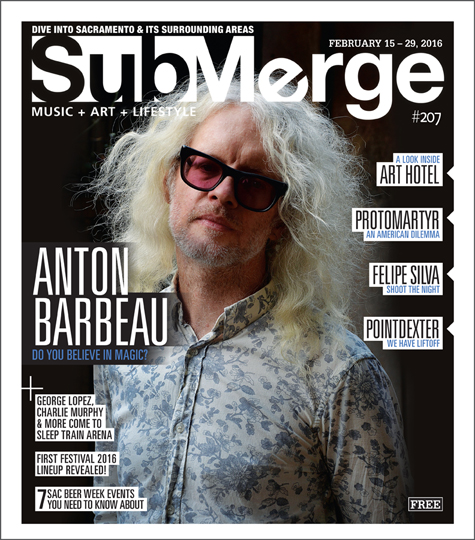
Sonic High
What do you do when you are raised on classical music, majored in music in college and played the flute in high school? Start an electronic dream pop band, of course.
That’s exactly what Jeremiah Tsering did when he and four friends—Mark Johnston on guitar, Phillip Moskalets on bass, Dave Moskalets on keyboards and Mark Tuzman on drums—launched The Good Fortune last summer.
“I’ve always had an urge to write, since high school, which was not that long ago. I started playing guitar first then my goal switched over to writing because I kept having all of these sounds playing in my head (I sound like a crazy person), but eventually I was around some people who inspired me to just start recording,” Tsering says.
This urge eventually metamorphosed into a full-on musical effort when Tsering and Johnston were approached by a friend to fill a last-minute slot at a show at Lounge of Life. The fortuitous event would prove to be the catalyst from which The Good Fortune would emerge.
“It was kind of an accident, we had a friend who asked us to play just this one-off [show], and we did a bunch of cover songs and a couple of originals, and it went really well,” Johnston says. “The band meshed really well, and [we] just decided to roll with it because we got a really good reaction and then we accidentally became a band, and it’s been fun.”
While each individual member of the band wasn’t new to the music scene (all five have played in other musical projects and bands), they admit that throwing together a quick set list and forming a band on the fly was a challenge, but one which they fully embraced.
“It was the most bizarre, euphoric thing, Johnson continues. “We walked on stage having no idea what was going to happen and thinking ‘Let’s hope they like the cover songs.’ And people were dancing, people really got into it and we walked off stage and into the green room and we just looked at each other like, ‘That really just happened. OK let’s do another one of these.’ We thought it was going to be a one-off but it was the best. There’s an intangible to getting off stage and going ‘People who I’ve never met in my entire life just liked what I did.’”
The accidental band then forged on, playing shows at small venues and cultivating and honing their lush, dreamy sound. Soon the fivesome were being invited to play at larger gigs, culminating with a performance at this summer’s THIS Midtown block party, a stint at Sam Sascha Keshavarz’s Le Twist Tuesdays dance party and a slot on the bill at the Submerge Presents Lipstick! New Year’s Eve party at Old Ironsides. But all of the attention hasn’t distracted the band from their mission to bring a soulful and thoughtful voice to the local music scene.
“I always had this dream of playing in a band and bringing a team with me and not doing something super selfish—there’s a lot of people out there who write and say ‘It’s all about me,’ so I think it’s really cool when you can do something and involve other people and they can find their role and everyone kind of grows with you, and that’s what it’s been like so far,” Tsering says.
The longtime friends cite their diverse musical backgrounds and interests as the spark that ignites their collective passion for bringing their distinct vision of music to life—a vision that strives to balance professionalism with a collaborative spirit where all of the players are empowered to have fun and enjoy themselves.
“We all respect each other as musicians,” Johnston says. “Our bass player Phil has surreal amounts of talent. He’s incredible. One of the other guys in the band, Dave, he was in Nashville like two years ago writing country music. Jeremiah grew up listening to a bunch of progressive, indie rock bands, and I grew up listening to metal and hardcore. But all of those influences … and all of us really respecting each other’s musical backgrounds, and really liking the central vision for what we do, makes it such a fun experience.”
The band’s first EP, Social Crowns, was recorded in Tsering’s home studio and was comprised of a collection of songs that the singer-songwriter had been amassing since his senior year in high school. The experience of writing and recording was a therapeutic experience for the singer, who admits that the process helped him get through a bout of depression and that the music is more than just catchy verses and tunes.
“A lot of those songs I started writing even before we got that first show—probably like a year in advance, in total,” Tsering says. “I’ve been writing pretty consistently since senior year of high school. When music really affects me it bypasses all of the senses and goes straight to the soul and emotions, and it’s almost like a high, it’s crazy. My goal is to have real-life messages that we talk about, that make people think about the lyrics, not like, ‘Oh, this is a catchy tune or this is a catchy verse.’ I want people to think about it a little deeper and maybe understand the meaning of the song or question what it’s about.”
And that is what is at the core of TGF’s musical philosophy—a longing to encourage an honest and thoughtful dialogue about everyday life that isn’t pretentious or isolating that celebrates Sacramento.
“I actually ranted about this the other day on Instagram,” Tsering says. “I see Sacramento as we’re laying a foundation for something, and I feel like a lot of other cities and the world has kind of looked at Sacramento as a second-class city, and I like that. I’ve always felt like the underdog, I’ve always felt like I didn’t really have everything but if I was diligent enough I can go ahead and get to the place I need to be, so that’s where I see Sacramento. Especially with festivals like TBD and how that’s growing, and I see the growth of these things and I just want to be part of it and contribute as much as we can to show people that Sacramento isn’t some random city that you just pass through; we have culture, we have a lot of great things.”
The bandmates’ love for music and the magic that a live performance can conjure is also at the center of what they want to bring to the vital Sacramento music scene. As the band looks to the new year, they’re encouraging themselves to continue to push forward. They’re currently working on news songs and hope to release their first full-length effort next year while also embracing the DIY ethos that is at the heart of the new music business by looking to create a series of music videos on YouTube. Oh, and if we’re lucky we might even see Tsering bust out the flute during a future performance.
See The Good Fortune live at Old Ironsides as part of the Lipstick New Year’s Eve party, presented by Submerge. DJs Shaun Slaughter, Adam Jay and Roger Carpio will also be on hand. Admission is just $10 and the party starts at 9 p.m. Go to Theoldironsides.com for more information.
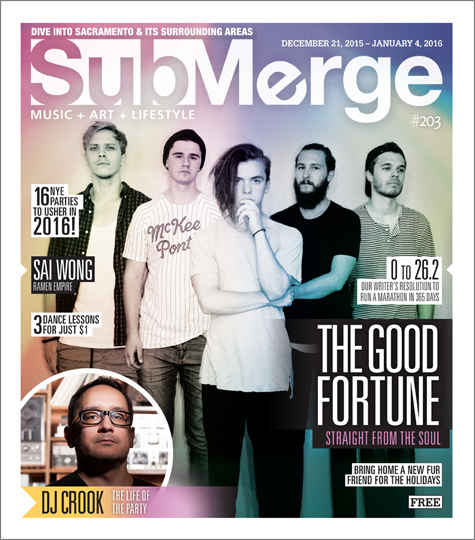
Visceral Sound Creation
While most teenagers in the ’90s were navigating their way through the precarious world of acne, young love and algebra, Andrew Southard—also known as Young Aundee—was honing his skills as a musician and launching his career as an electronic, hip-hop and trip-hop beat maker while learning to master the melodica, a harmonica with a blow tube, but more on that later.
With a calendar full of DJing gigs, including a slot at Submerge’s upcoming 200th issue party, and a new four-song EP release titled Caveat Emptor that features two vocal tracks and two heavily layered instrumental cuts, Young Aundee is hitting the local music scene hard this year.
“The first song ‘Amazing Grace’ is a beat that Dusty Brown had since 2007. We made some modifications to it,” he explains. “There’s no [specific] concept to it, but the name caveat emptor is a sales term that means let the buyer beware, so I thought it would be kind of applicable, like when you apply yourself to art and music you kind of have to take whatever discomforts come with the bad and the good.”
As he approaches his second decade of making music, the performer has amassed a catalog of music that ranges from punk rock to hip-hop, but says his journey as a singer and performer is still ongoing as he continues to cultivate his talents.
“In the more live, songwriting atmosphere, I’m still coming into my own,” he admits. “Self-consciousness is still a problem for me, so when I do feel like I connect [to the audience] it means a lot to me. I guess ultimately that’s what I’m trying to do is connect.”
Making connections is a language that Young Aundee speaks fluently—he’s played with local and national acts ranging from Sister Crayon to witch house maestro oOoOO, and maintains a long-running musical partnership with Sacramento electronic impresario Dusty Brown. As he gears up to bring his latest project to life, Halftone Society Rhythm Section—a musical alliance he formed with producer Benji Illgen who performs under the name Mophono—Young Aundee says that the act will be a clandestine event shrouded in ambiguity.
“It’s a collaboration between a bunch of different musicians in the San Francisco jazz scene and also a couple in the beat music scene,” he explains. “Mophono [is] trying to keep it as elusive as possible, you’ll never know what it’s actually [all about] until you go to the show.”
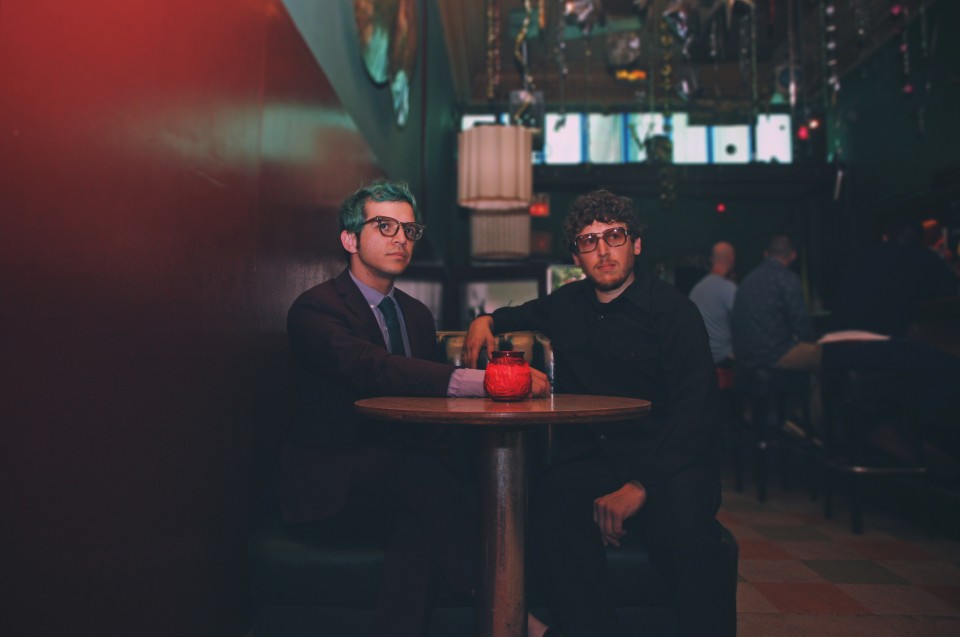
{Young Aundee with Mophono / Photo by Jen Wong}
A Young Aundee performance is both heterogeneous and unpredictable—drawing from his eclectic range of musical interests, his mood-drenched lyrical style combines genuine openness with raw, unapologetic observations of the world around us. Layered over a menagerie of twittering synths and methodical beats, his music is a reflection of the diversity that directs his musical compass, coalescing in a sonic wave that is both hauntingly beautiful and straight-up ear candy.
“The first band I ever played in, I was a keyboard player and it was kind of a Cure, pop thing,” he recalls. “I loved the feeling that we were creating something that was our own, as simple as that sounds, it’s true.”
When he isn’t constructing beats with Brown or tackling the logistics for the Halftone Society Rhythm Section album release party set for the end of the year, Young Aundee also throws down with the hip-hop group Who Cares. In fact, it was through his association with this act that Young Aundee established one of his favorite collaborations, with the ’80s Los Angeles dance scene legend Egyptian Lover.
“My very first show with Who Cares was in 2005 at the Mezzanine in San Francisco. It was the first time we ever performed a song called ‘Space Love,’ which is kind of on that freestyle, Debbie Deb, Shannon kind of shit, and the chorus in that song is straight-up like an ’80s radio song,” he recalls. “So he heard that, and ever since then we’ve kind of been on his radar. We approached him to collaborate on a track and he was available and was actually excited about the idea. To say that I worked with a dude that created a sound, especially on the West Coast, is a big deal to me.”
Creating sounds is Young Aundee’s jam—the soundscapes he constructs, whether performing live with Who Cares or standing behind his laptop churning out beat-drenched grooves at events like this week’s ArtMix at the Crocker Art Museum, draw from his wide-ranging musical pursuits, including the melodica.
“I started playing the melodica because of my connection to dub reggae music; it was made famous by a guy called Augustus Pablo in the ’70s,” he says. “I started playing it in my first band called Secret Six. We were like Bad Brains and Operation Ivy, that punk-reggae, but not the Sublime kind. Yeah, I call that Beach Hut Deli shit, they always have the Pandora station on Slightly Stoopid and Pepper, and all that horrible shit. I can’t stand it. You have to smoke dabs to feel that shit, the highly concentrated shit.”
And while he’s been making music since the days when he recorded original tunes on his four-track recorder at 14, Young Aundee says that his sound has evolved organically through the use of technology, but also as a result of his close relationships with his trusted production team.
“The dudes I work with predominantly are Dusty Brown and Benji, who are like two of the most underrated electronic music producers in Northern California,” he says. “I’m super lucky and blessed to be able to work with them on a regular basis.”
“I usually work with a lyricist, but I also write my own stuff out of necessity,” he continues. “I’m more of a singer and a part maker before I am a lyricist. I’ve worked with one of my best friends since I was in high school, his name is Jeremy Dawson and he collaborates with me on probably 70 percent of the lyrical content.”
The word visceral gets thrown around a lot around these days, but from Young Aundee’s purgative debut album, 2013’s Fear in the Fold, to his latest exploits with Halftone Society Rhythm Section, the singer-lyricist-beat maker says that it is because of those guttural, agonizing experiences that creativity emerges from the dark recesses of the spirit, both in and out of the studio.
“That’s what David Sedaris’ books are like for me, they make you laugh [but] they also kind of make your heart drop,” he explains “A lot of comedy does that for me; a lot of comedians are deeply disturbed, depressed individuals, that’s why that shit comes naturally to them.”
With Caveat Emptor hitting the streets and a full-length album he hopes to release in 2016, Young Aundee is hitting his musical stride. But it is his dedication to the exuberant exploration of the sonic world through bold experimentations and by taking risks that belie his quiet demeanor and allows him to draw in and connect with the crowd.
“Music is pretty transient, so it’s super rewarding to connect with an audience,” he says. “I don’t call myself a DJ but I think that’s the language people can adapt to more than the original music thing, so I’ll take it as it comes.”
Catch a Young Aundee DJ set for free Sunday, Nov. 15, 2015, as part of the Submerge 200th Issue Party at LowBrau, located at 1050 20th Street. The event will also feature live performances by Contra, Sunmonks, DLRN and Joseph In the Well. The party is free, 21-and-over, and begins at 5 p.m.
There and Back Again
In the new video for the song “Test Yourself” off Sea of Bees’ latest musical effort, Build a Boat to the Sun—a 10-song voyage through the band’s singer-songwriter Julie Ann Baenziger reconnection with music after a brief hiatus—Baenziger and her musical cohort Amber Padgett channel their inner Girl Scouts and commune with nature in a playful romp with the snails and butterflies that inhabit a wooded glen nestled against the craggy cliffs lining a frothy, churning sea.
The video, shot by Padgett and fellow local creative Jyoti Alexander along the breezy trails and parks in Stinson Beach, channels that feeling of wide-eyed innocence that permeates much of the Bees’ musical catalogue and marks Baenziger’s return—not only to the 916 but to creating new music.
Coming off the heels of a successful musical residency at the Ace Hotel in New York, Baenziger is diving back into her Sacramento roots, heralded by a return to the stage in a homecoming of sorts with shows lined up this month at the Warehouse Artist Lofts and Sophia’s Thai Kitchen in the continuation of the musical journey that began as a teenager.
“When I was younger, about 15 or 16, that’s when I realized I could create things,” she explains. “I was existing to create things, I liked to draw a lot, but I was really introverted.”
It wasn’t until she stumbled across a musical duo at church and became transfixed by the lure of music that she began to emerge from her shell. It was then that her creative yearnings metamorphosed from pictures into harmonies.
“There was a boy and a girl; a sister and a brother, and they were playing guitar and singing,” she explains. “And I was just taken away by them [and thought] I could maybe do something like that. So that was kind of like an invitation. Also I was crushing on the gal a bunch.”
Following that transformative moment, Baenziger spent the remainder of her teenage years secreted away at home, teaching herself how to sing and play the one-stringed bass guitar that one of her brothers had cast away into the dark recesses of the family’s shed. Certainly, the road to tours along the West Coast, shows in the United Kingdom and residencies in some of New York’s top venues—she also played a stint at the Living Room in the Williamsburg neighborhood of Brooklyn—didn’t come without its frustrations and long, grueling hours of learning how to master the intricacies of the bass.
“I’d pick [it] up in the mornings before I’d go to school and try to tune it. I didn’t know how to tune it so I’d just turn on some music and try I’d to emulate that and try to make the same sound,” she says. “So I was really trying, it took five years of misery—my fingers were callused, I didn’t know how to tune, but then it became just my life.”
If turning heartbreak and adversity into musical gold was a commodity, then Baenziger has cornered the market on making melodious magic from the treasure trove of instruments she continues to master as a self-taught musician. Now in her sixth year of fronting the Bees—a sometimes one-woman act that moonlights as a duo or full-fledged band—the songstress says that her music’s evolution isn’t an act of premeditation, but is rather a reflection of her experiences.
Sea of Bees’ first album, Songs for the Ravens, what Baenziger calls an explosion of delving into the pent-up emotions of feeling limited and restrained, was a way for the artist to discover the joys of the self. The second album, Orangefarben, was a much more personal piece of work and a catharsis of sorts. The album follows a time of turmoil, during which Baenziger came out, went on her first tour to promote her debut offering and ended a relationship with her first girlfriend.
“The second record was more of the experience of a break up. It was just very direct and in the place where I was at I was limited—I couldn’t explore, my feelings were walled up,” she admits.
With the release of Build a Boat to the Sun, which she recorded under the guidance of her longtime manager John Baccigaluppi at his new recording studio, General Produce in Sacramento and Panoramic Studios in Stinson Beach, she says she’s learning how to explore again, where there are no restraints—both in her life and in the way she approaches her music.
“It’s crazy, now I feel like I’m back. Not back to the beginning, but back to this place of like no limits, which is nice,” she says. “There’s no emotional limits, there’s nothing that can stop what I want to try, whether it be some Afro beat, or just anything, I can do Indian chants, it’s limitless, so it’s very refreshing to see what happens.”
As the songbird prepares to bring Sea of Bee’s back to the home stage, it’s clear that the “Test Yourself” video is truly a reflection of her eagerness to delve back into the waters of creating harmonies that convey her desire to wash away the limitations of her former selves. With every “la la la,” her voice soars with the confidence of her enthusiasm to create. But, for now, she’s looking forward to reconnecting with old friends and revisiting older tunes that she is ready to tap into again—and don’t be surprised if she throws in a few surprises too. She isn’t ashamed to admit an affinity for the musical stylings of pop royalty Katy Perry.
“Amber and I were talking about the upcoming shows. We’re going to keep it really lo-fi for the Sacto show, that’s going to be a super fun show, though,” Baenziger explains. “I think we want to do more of the older songs because I’ve strayed away from them for so long. I have to get to that place where I just enjoy playing them. Sometimes you’ve got to go back and revisit them and just kind of connect again and enjoy the process.”
As for the Davis show, Baenziger says that’s when she’ll pull the big guns out and employ the talents of a full band. Her excitement resonates throughout the coffeehouse where she reflectively sips on her caffeinated beverage of choice—a steaming cup of coffee.
“We’re going to have some good friends play with us,” she says. “Be expecting a big fat hug of music. Be prepared to be embraced by the sound.”
With just a few shows planned, Baenziger says that with the fall equinox she too is looking forward to a fresh start musically and personally. She calls it a rebirth of sorts and reconnecting with old friends has been a large part of her inspiration as she embarks on new musical exploits.
She is currently working on her fourth album, which she hopes to wrap up in December and release in the spring of 2016 and is embracing the feeling of her current mantra of casting away any limitations, of being limitless and finding happiness back among her friends and fellow musicians.
“You’ve got to feel good. I don’t want to feel shitty anymore, I’m so tired of it,” she says. “Everybody deserves to feel good and I’m excited for the future of things. I have been actually excited about making music. No limits that’s my thing.”
Give Julie Ann a warm welcome home at two upcoming shows: The first at Sophia’s Thai Kitchen in Davis on Oct. 22 (tickets are $8 in advance and the show starts at 9:30 p.m.), and the second is a special rooftop show at the WAL (1108 R Street in Sacramento) on Oct. 23 at 7 p.m. with Sunmonks and Jacob Golden.
Chill Vibes
As the noble salmon swims upstream, battling the current during its long journey from the sea to the rivers and streams of its birthplace, it never loses sight of its mission—to arrive at its final resting place in the waters of its birth. Billy Ngo, the man who redefined and refined the ritual of eating sushi in Sacramento with his venerated midtown fish house, Kru, is very much like the salmon—driven by a singular mission to dazzle the palates of everyone who bellies up to his sushi bar.
Like most of those who have come up through the ranks of the gastronomical arts, Ngo started at an early age. He cut his culinary teeth among the humble class of busboys but soon crawled out from under the mountain of food encrusted, castaway dishes of the sink and into the fires of the kitchen. As his culinary skills grew, so did his reputation. Notably one of the best chefs in Sacramento, Ngo has legions of fans, is well-respected by his peers and is constantly looking to elevate his fish game—his menu at Kru is a testament to his visionary approach to cooking with dishes like beef tongue that arrives in a swath of wasabi and mustard aioli and, quite possibly, the best bowl of soup in town with his duck confit ramen in sumptuous and deeply seasoned spicy miso broth.
Not one to rest on his epicurean laurels, the chef/owner of one of the most inventive sushi restaurants in the region is expanding his vision and looking to the islands of Hawaii for inspiration with his latest venture, Fish Face. The dining experience at Fish Face is casual. It’s a laid-back joint that serves one thing, and one thing only, poke. Diners select the fish from a variety of aquatic offerings—from the tame, like salmon and tuna, to the exotic like thinly sliced octopus—along with the sauce and other accoutrements such as jalapeños, avocados and daikon sprouts that will adorn their fresh catch.
Submerge recently hooked up with Ngo at his new digs in the Warehouse Artist Lofts building to talk about the inspiration behind bringing this raw fish salad from the shores of Hawaii to the streets of Sacramento and his experiences coming up in the local food scene.

What inspired you to start cooking?
Well, I don’t really cook, I just cut fish [chuckling]. Really the first job I ever had was at a Japanese restaurant as a busboy and then moved up to working to the sushi bar as a sushi prep [cook], but it was just a job to me—I didn’t really care. Then I went to college, but I didn’t like that, [being] in the classroom so I just started really doing what I was doing so I was like, “If I’m doing this, I want to be really good at it,” and then just bounced around from different places learning different stuff, then I wanted to open my own place because if I want to work, I want to work for myself.
What was your first restaurant?
Kru. It’s been 10 years now.
I heard Kru is moving. Why move and where are you moving to?
East Sac, the Andiamo building on Folsom and Alhambra. The reason for moving is the space we’re in. I love the location, it’s awesome, but we just outgrew the space and it’s an old building. You know, Celestin’s was there for about 15 years then a couple of other restaurants and then we took over, so it’s just an old building that’s falling apart. Also I just want to get a real grown up kitchen. Right now that space is so tiny, the kitchen is the size of a closet—it’s just a hallway and you’ve got three guys in there bumping into each other. We do really cool, fun stuff out of that space right now and people see what we’re working with, it’s crazy. So it’s kind of cool to have a real kitchen for the team to work out of. We’re going to be splitting it with The Selland’s Group. They’re going to be doing a restaurant there so it’s perfect because we’re good friends and we’ll be neighbors now.
When will the doors to the new Kru open?
It’s projected for November, December, so I say maybe February, March, April next year.
What was your experience like interning at The Kitchen?
It was awesome. Before I only worked in Japanese restaurants doing sushi, and when I realized I wanted to open up my own restaurant, I went to culinary school because I always knew that if I wanted to open up my own restaurant I needed to know both sides … I went to dinner there right before I went to culinary school and it just blew me away—the service, the ingredients. I talked to Randall that night and said, “I’m going to culinary school and when I come back I want to do my externship here,” and he said yeah.
What was the biggest takeaway you got from working at The Kitchen?
The most important thing is your ingredients—working there I learned you don’t go cheap on the ingredients. You start with a good ingredient and you don’t have to do much to it. I worked at a lot of places where I didn’t know about quality and then working there I learned that there is way better stuff out there and you can’t go cheap. You get what you pay for. That’s what they do at The Kitchen, Randall never compromises on quality.
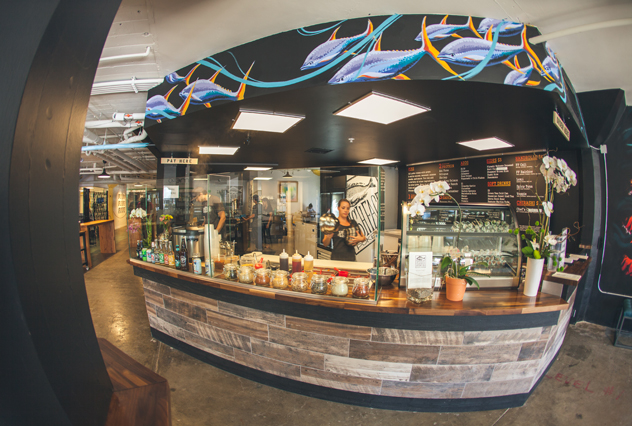
With your new venture Fish Face, what was the inspiration for bringing poke to Sacramento?
It just felt like it was something we needed in Sacramento, there’s nothing here like that. One of our partners, we have four partners here, she loves poke. We were in Burbank for me to film Cutthroat Kitchen, and we went to this little poke bar and I thought, “This is such a cool concept. It’s a super casual vibe, super chill,” and she said, “I wish there was something like this in Sacramento,” and I’m like, “Why don’t we just open one, we already have a sushi bar, we already have connections to fish and it will be so easy.” Then we came back and I threw around the idea with my business partner at Kru. Then this place popped up, but we couldn’t cook here because there’s no hood and then we thought, poke!
What was it like being on Cutthroat Kitchen?
It was interesting. It was a good experience, but going through the filming and seeing the TV magic it’s pretty crazy. What you see on TV, the 20 or 30 minute show takes like 18 hours to film. The kitchen part is real, but there are so many times that you film the action. It’s not just them filming you during the competition, it’s a lot of retakes just to make it look good for TV. It was a long day, then you have to come back the next day to do the interviews. The worst part of it is your sitting in the back just chilling until they call you to come out to do the next scene or whatever they need you to do, so it was interesting but it was fun.
I had the pleasure of eating your dish at Have Another Offal Day last year, but what I really noticed was the camaraderie among you and the other chefs that were participating. Are you all just one big happy family?
Yeah! Sacramento is really special and different because all the chefs really do get along, in other cities it’s more competitive. Here we call each other up and say, “I ate at your restaurant last night and that sausage was really good, can you give me the recipe?” We all share and we all support each other to make the restaurant scene better as a whole. Something like Have Another Offal Day is like a big party to us. We just hang out, we’re all drinking with each other and it’s something fun for us to get together and do outside of our restaurants.
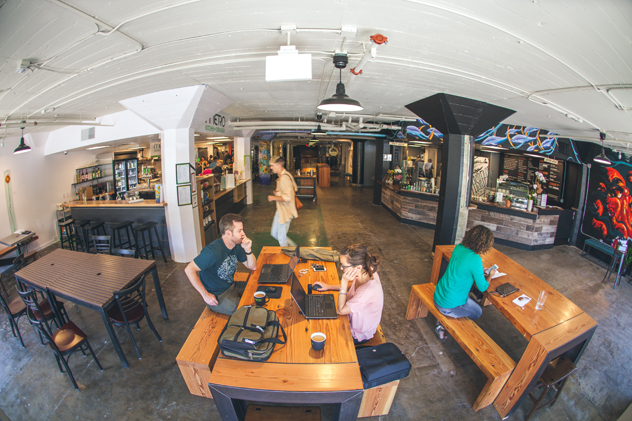
Fish Face Poke Bar is now open at the WAL Public Market, located at 1104 R Street, Sacramento. You can learn more about the restaurant at Fishfacepokebar.com.
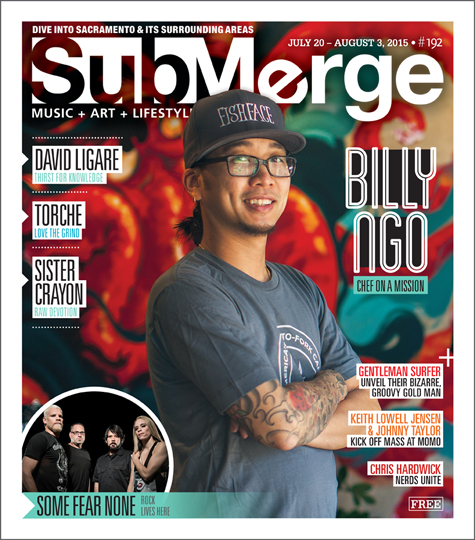
Changing with the Times
In the ’80s, the culinary landscape in America was at a crossroads: Across the nation voracious diners were relinquishing their steak knives, and squeamishness, in favor of a pair of chopsticks to embrace sushi’s raw state; chefs were dabbling in inexplicable versions of tried and true favorites (Wolfgang Puck’s experimentations with pizza come to mind); while others toyed with our appetites entirely with nouvelle cuisine—you know, those overwrought, outrageously priced plates that displayed more porcelain than actual food. It was indeed a brave new culinary world.
During that same time a local gastronome was taking on the dining scene in Sacramento. Unlike some of his contemporaries, Randy Paragary refrained from such novelties and instead focused on composed, yet accessible, dishes when, in 1983, he opened the doors to what would become the flagship of his epicurean empire, Paragary’s Bar and Oven.
Over the last 30 years the venerable eatery played host to marriage proposals, birthday celebrations and business negotiations. But during its tenure as one of the best restaurants in town, owners Paragary, his wife Stacy and chef Kurt Spataro decided it was time to do their own restaurant makeover—updating not only the bistro’s façade, but its interior, patio and menu. So, last spring the duo shuttered the doors and embarked on the journey to reinvigorate the esteemed establishment.
For 15 months, diners held their collective breath in anticipation of the million-dollar rebirth of Paragary’s Midtown gastronomical mecca. They were rewarded for their patience with a decidedly French take on the classic that’s modern without being too heavy-handed in its design—subtle touches are sprinkled throughout the space that are evocative of both old world charm and a nod to modernity. The updated menu mimics that sentiment as well. A few of the hits include fluffy pillows of sheep’s milk ricotta gnocchi intertwined with luscious chanterelle mushrooms, sweet corn and fava beans afloat in a parmesan brodo; a bold mesquite grilled quail dish intermingled with sweet corn soubise, fennel and arugula sprinkled with bits of bacon in a sweet bourbon marmalade; and an appetizer of thinly sliced, chilled lamb’s tongue adorned with frisée, French breakfast radish and a sauce gribiche—an herbaceous mayonnaise-style, egg concoction riddled with the briny goodness that only the caper can lend.
Submerge recently sat down with Spataro to chat about the old, the new and the unexpected at the new Paragary’s.
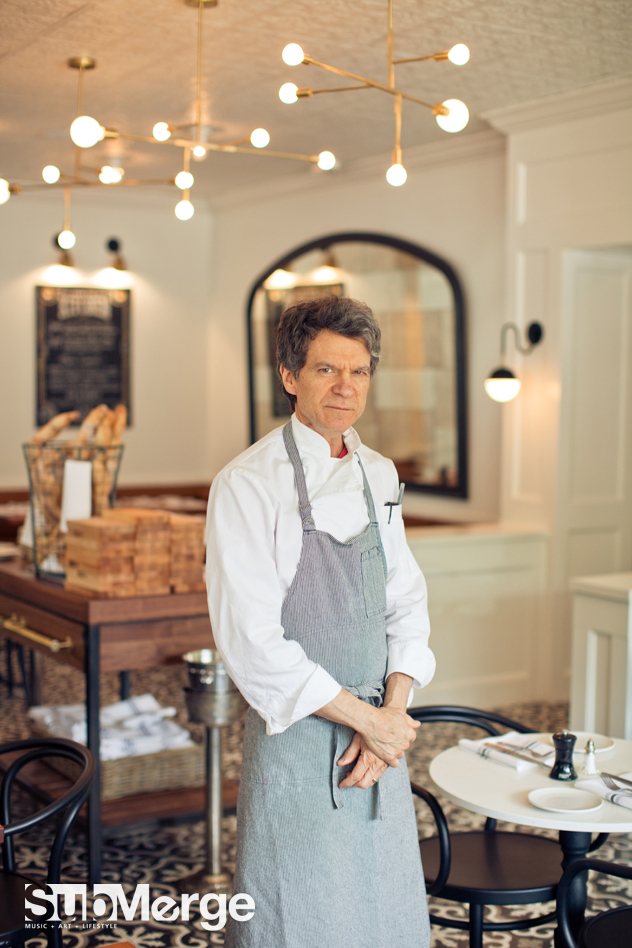
What is the inspiration for the food that you’re doing here now?
When I was very young, maybe 19 or 20, I stumbled upon Chez Panisse in Berkeley … I had dinner that night and it had a really huge impact on me. [When] the Chez Panisse menu cookbook came out, I got a copy and I read it like a novel, from cover to cover, and I cooked my way through it. That whole experience, discovering Chez Panisse, going there and eating as much as I could, collecting the menus, studying the menus, studying that book [and] using my experiences at Chez Panisse as a reference really set me in a direction. That experience was very formative.
What was the reason for revamping both the space and the menu?
The space needed it, for one. It really needed to be updated. I think the menu is a collaboration between myself and the chefs … and the history of Paragary’s certainly influenced the menu, but there are so many things that have happened since Paragary’s opened 32 years ago, in terms of the culinary scene, and we wanted to incorporate those things [but] still be somewhat faithful to the original concept.
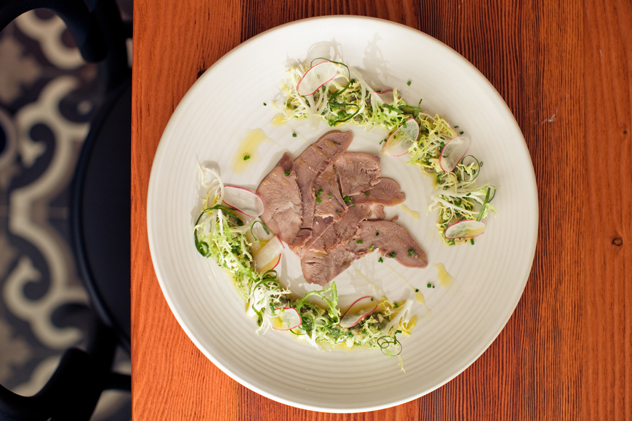
What was the most audacious food trend when Paragary’s first opened in 1983?
Things that were introduced at that time, you know, goat cheese was kind of a new product at that time, and things like sun-dried tomatoes. So, I guess what was silly about it was some of those things got overused. Soon there was sun-dried tomatoes on everything and goat cheese on everything. So, that to me would be it—the overuse of trendy stuff.
I saw chilled lamb’s tongue on the new menu. What’s your take on “snout to tail” eating?
I think it’s great. Chefs like the weird stuff. We like to use interesting things. It’s not that interesting to cook a boneless chicken breast, or challenging. It’s much more interesting and challenging to take something like a lamb’s tongue, or oxtail, or tripe, you know, something that is very unappetizing in its raw state and you have to use a lot of technique to make it delicious. So it’s always fun and rewarding to take something like an underappreciated ingredient and apply technique and time to it and make something delicious that you would never make at home.

What do you think is the most significant change to the restaurant?
Physically, I would say it’s completely different. I think the spirit is very similar; it’s intended to be comfortable and a place where you can come any time of the day and feel comfortable … but the appearance is the most strikingly different thing.
Was there anything in the restaurant that is no longer here that was heartbreaking to lose in the redesign?
I don’t know if you remember the mural that was painted on the ceiling; that was there from day one and it was hand-painted by someone. So seeing that being peeled off of the ceiling was … well, it wasn’t sad, but it was, “Wow, we’re really changing things.”

How do you stay relevant in an industry where diners are fickle and restaurants come and go?
I think you really have to pay attention to what’s going on, and there’s so much information out there from food blogs to magazines, cookbooks. I’m a voracious reader and collector of cookbooks, and traveling and going out to eat at other restaurants, all of it. Really trying to stay abreast.
Being in the business for so long, what advice would you give to a young entrepreneur thinking about getting into the restaurant business?
Besides, don’t do it [chuckling]? I think my advice would be, just be really sure of what your concept is. Secondly, don’t overextend yourself. I think it’s a mistake for a first-time restaurateur to go deep into debt. I think it’s smarter to create a more modest concept, sort of prove to yourself and to your customers that this is going to fly. In order to mitigate the risk it’s smart to start small—really be clear on what your concept is and do it great.
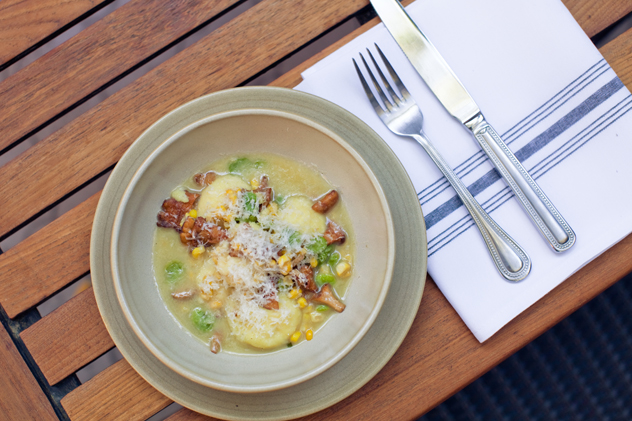
What is the most remarkable change that you have seen in the local food scene?
The level of sophistication and quality. I think the bar continues to get raised each year and that’s great for the diner, because the restaurateurs have to compete with each other and the chefs have to compete with each other. So the more people out there doing good things the more we have to step our game up.
Paragary’s Bar and Oven is located at 1401 28th Street in Sacramento. For more information, go to Paragarys.com. You can also call (916) 457-5737.
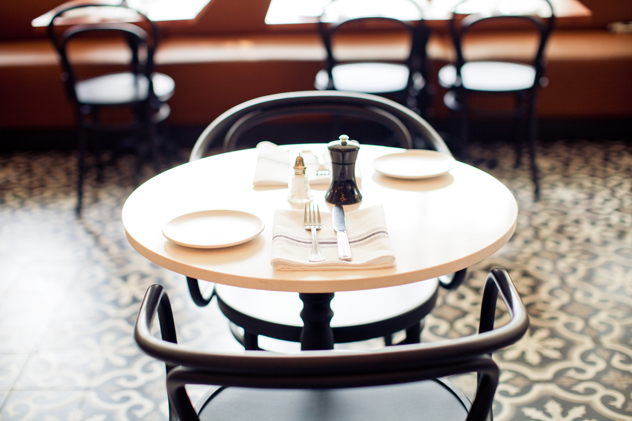
This Band Walks Into a Bar …
So, two fat guys, a Mexican and a Japanese girl start a band…
What’s the punch line you ask? Dead Dads.
“Yeah, Dead Dads is the punch line,” Tony Silva of the Sacramento pop-punk band Dead Dads explains of their Facebook page’s band description. “It’s kind of like that NOFX album, White Trash, Two Heebs and a Bean.”
“I think the three of the guys in the band are pretty immature and Lys is mature,” lead singer and guitarist Cory Wiegert jokes.
All jokes aside, if you’ve been around the Sacramento music scene long enough you know that bands are not just bands—they’re bands, within bands, within bands…well, you get it. A guitarist may moonlight in another band as its bassist, or a drummer may trade in his sticks for a guitar strap—Multi-instrumentalists are commonplace in this town.
Such is the case for the members of Dead Dads: its frontman, Wiegert, also plays guitar and sings backup vocals in the local bluesy rock band the Peace Killers, while Lys Mayo on the drums, guitarist Tony Silva and bassist Joe McKinney, also known as Joe Friday (yes, inspired by the character on the TV show Dragnet) also lend their skills to other musical outfits around Sacramento.
While the band also describes its brand of musical stylings on its Facebook page as “stoner pop-punk,” Dead Dads’ music is a fun romp in the world of pop-punk—you know, the cousin to punk, a fusion of fast punk beats and blaring guitar riffs with pop-y melodies and arrangements.
“When we first started, we didn’t want to just call ourselves pop-punk because we were mixing all of these kind of weird riffs and such, and so we started saying stoner pop-punk,” Silva explains. “I think it is a good way to describe us—I mean really we’re a pop-punk band. We take a lot of influence from the Bay Area pop-punk bands.”
The quartet began simply as a band of friends—going to shows and hanging out around the Sacramento music scene. What started off as something fun to occupy their time quickly grew into a full-fledged band.
“Our first show was in November 2011, and we had our first practice, probably, late September/early October 2011,” Silva explains.
“We didn’t practice very long before we started playing shows,” Wiegert chuckles.
“Our first show was for one of Danny Secretion’s cancer benefit shows,” McKinney explains. “And it was at this venue that was also an art gallery in Midtown—which I guess wasn’t a totally legit venue, it didn’t have the proper permits or anything. The name of the venue was a venue called, Digitalis, the show was going well and we were probably the fourth out of five bands [on the bill] and right as we were finishing up our last song the people at the venue working there came and said, ‘Hey, you guys got to stop…cops!’”
While the police may have busted up the renegade show, the band forged on and their efforts transformed from just playing music and having fun into a serious musical endeavor—ultimately materializing into their first EP, simply titled Ben.
“Once we did our first recording it started to get a bit more serious,” Wiegert explains. “It really was just to play local shows as first; we hoped we could do more than that. We’re just now starting to venture out of town, but there wasn’t a particular goal in mind. We found a small label to put out our album and I guess that was somewhat of a goal.”
Huddled around a cell phone in the back of Wiegert’s dark blue Dodge Caravan in the parking lot of their practice space (House of Hits Recording Studios in Del Paso Heights, near the Marconi-Arden Arcade light rail station and next to the 7-Up factory), the quartet spoke to Submerge about their early influences, the driving force behind their sound, the dynamics of the band’s creative process and their latest album Space Camp.
“I was a band geek starting in fourth grade, I played trumpet and all that stuff and then I heard Green Day and saw [the movie] School of Rock and I decided I wanted to play drums, and that was that,” Mayo says.
“Not many of the people my age like the music I like, and the specific music I had in my head that I wanted to play, which was some sort of pop-punk that was reminiscent of the old Bay Area pop-punk bands,” Wiegert, the elder statesman of the band, explains. “And we all smoke a lot of pot and get weird, so it just really worked out that way.”
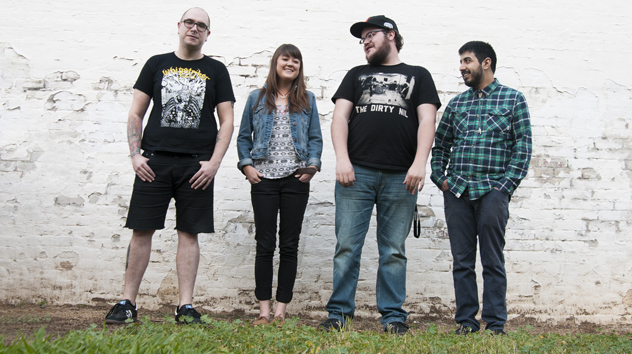
And while you typically don’t see many females in town wailing away behind the drum kit, Mayo is quick to dismiss the idea that being a woman in a band with three dudes is anything remarkable.
“I don’t think it’s any different than having a group of four guys or anything like that,” Mayo says, elaborating on the guy-girl dynamic in the band. “They’re just my three best friends, so we inspire each other, we drive each other nuts, we write good music, we write some bad music, it’s not that much different than [any other band out there] … I’m in a band with girls as well, [and] to me I don’t think gender plays a huge role in the dynamic.”
The band’s second EP, released earlier this year, was recorded by a mainstay in the local music scene—Patrick Hills, who is also a musician in the punk band Bastards of Young. However, it wasn’t something that the group banged out in a couple of weeks—quite the contrary, whenever the band and Hills had any free time they chipped away at bringing the 10-song record to life.
“We started recording it, I think, at the end of the 2013 and we didn’t actually finish recording ’til probably around the summer of 2014,” Wiegert explains. “And then it took a long time for us to find somebody to put it out and everything. But we recorded it with a guy named Pat Hills at his place called Earth Tone studio in Rocklin. It was a long process; finally just in the last few months we were able to put it out.”
And yes, for all of you movie buffs out there, the inspiration for the album’s title did, in part, come from the teen flick Space Camp as well as a bit of mix-up with the lyrics during the recording process.
“What happened was, we were listening to Cory record his vocals for one song and one of the lines I thought he [sang that] he was going to space camp, and I just kept singing it over and over again and then yeah [it just stuck],” McKinney explains.
“Also, I missed seeing movies where people went to space camp. It is a total ’80s/early ’90s thing,” Wiegert continues. “When I was a kid I always thought it sounded so cool.”
The artwork for the cover, a collection of ethereal jellyfish on a black and gray space-like background, was brought to life by a friend whose artistic vision spoke to the foursome.
“We had a few different ideas…but a friend of ours Jessica Vosburg drew up the cover and then I colored it just using Photoshop and such—she did a sketch of it in black and white and we colorized it,” Wiegert explains.
“She drew that probably early 2014—it was probably one of the first album cover ideas we had and we tried about 30 other things and that was the one we always came back to, so two years later we liked it and chose it,” Mayo continues.
So, a jellyfish walks into space camp…OK, bad joke, but check out Dead Dads at their upcoming show and get weird!
For more info, checkout Deaddads.bandcamp.com or their Facebook page.
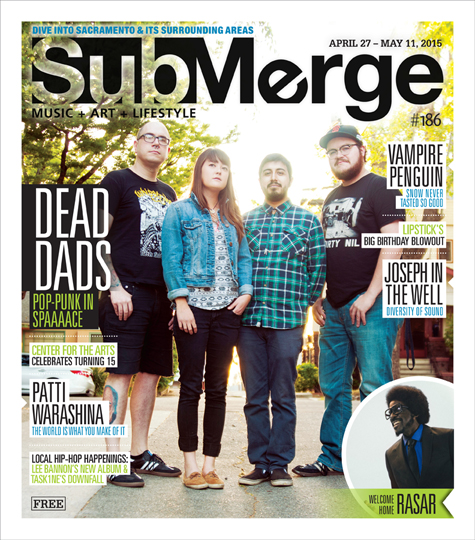
Micah Crandall-Bear’s latest body of work is a lot like the artist himself—a combination of precision and a minimalistic sensibility that draws heavily from a deep appreciation of natural beauty.
For those unfamiliar with Crandall-Bear’s artistic vision, the painter operates in the world of the abstract. His canvases are heavily layered acrylic landscapes of bold striations of colors focused on hard line compositions that explore the many nuances of something we see every day: the horizon. His technique is methodical and precise, implementing a traditional method that is typically associated with oil painting wherein swiftness is essential. Layers of wet paint are applied to previous layers of wet paint in linear brushstrokes that traverse the entire length of the canvas from left to right.
His latest body of work, titled Latitudes and is currently on display at Elliott Fouts Gallery through July 2, eschews cityscapes, but instead celebrates the refinement of nature.
“This show, instead of trying to be complex … is actually a bit more subtle,” Crandall-Bear explains. “It’s also more refined. There used to be a lot of exaggerated line and color, where in these paintings it’s got a little bit more of a desaturated feel. So it’s softer, more subtle.”
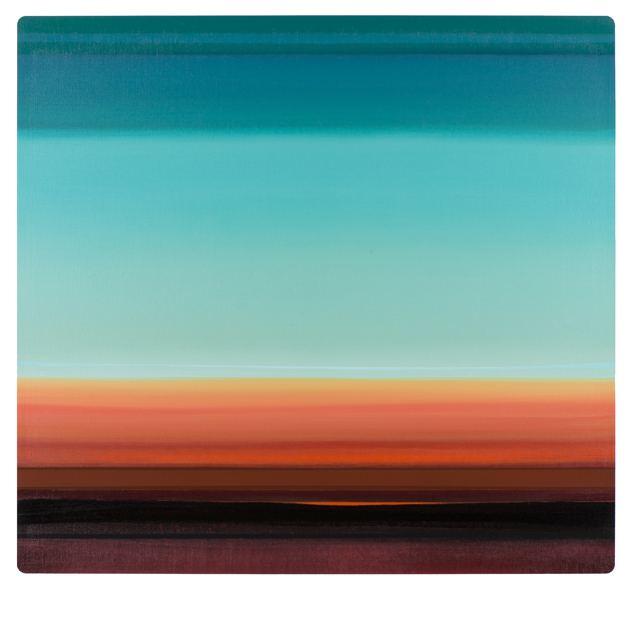
{Palm}
The artist recently invited Submerge into his airy studio to explain this latest collection of work and how an early experience at the Michael Himovitz Gallery on Del Paso Boulevard under the mentorship of then-gallery owner Chuck Miller led to the progression of his singular vision and ultimately into a successful career as an artist.
“I started interning there in ’98 or ’99, so toward [Michael Himovitz Gallery’s] later years. Michael had died already, but his partner Chuck Miller was running the gallery,” he explains. “I ended up mentoring under Chuck. He kind of took me under his wing, although he didn’t really care for my art, but over time he started selling my work and introduced me to designers like Paulette Trainor, you know, big figureheads in the community, so I was pretty fortunate. I was around that at a young age, which was great because I learned the gallery side before I learned how to be a career artist.”
And while the Himovitz gallery shuttered its doors in 2001 after a successful 20-year run, Miller and Crandall-Bear remained close, both personally and professionally, until the venerated mentor died in 2009. The lessons learned from that relationship still reverberate through Crandall-Bear’s experience as an artist—specifically one who still sees value in the gallery-artist collaboration, especially as many of his contemporaries look to other avenues for introducing their work to the world.

{Sublunar}
“Chuck and I continued to work together [doing] private art sales and design showcases. He basically just turned himself into a broker, an art dealer without the brick and mortar, but he sold art until he died,” he says. “So fast forward 10 to 15 years, there have been a lot of galleries that have come and gone, but the gallery world as far as representing artists is changing, especially with social media and Instagram. A lot of artists are using that platform, Instagram, as a sales platform, and they should: it works. There are a lot of artists in my community that don’t necessarily adhere to the gallery format like I do. As I said, I grew up doing that so it’s kind of what I always knew.”
Like most artists, Crandall-Bear’s work has been an exercise in evolution: from a series of figurative works with rigid urban tones, incorporating text, spray paint and elements of graffiti in the beginning, to the progression of a singular idea expressed through bold stripes and color fields.
Focusing on the work, Crandall-Bear’s art pieces have won him favor with art consultants, interior designers and corporations. And while his work adorns the walls of tech companies like Intel, skyscrapers in San Francisco, university hospitals, law firms, corporate and government offices and a slew of private residences, it’s the spirit of the local art community that has him really excited about Sacramento’s future as an emerging hub for creatives.
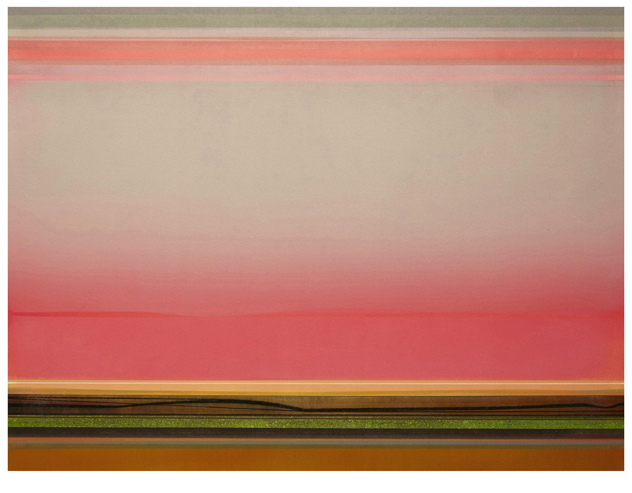
{Ultra Border}
“It’s an exciting community and I think right now it’s probably, as far as visual art, it’s the most exciting time in Sacramento’s history,” he gushes. “Right now there’s so much going on in the art scene with things like the [Bright] Underbelly [mural] project, WAL, Verge, Elliott’s gallery, and you want to be a part of that. You can liken it to other places, their story has been written, like San Francisco and L.A.; ours hasn’t and that’s exciting.”
As one of the artists whose work has contributed to the transformation of the historic 100-year-old Lawrence Warehouse into the Warehouse Artists Loft, a lofty experiment in a mixed-use, mixed-income community for artists located in downtown Sacramento’s Historic R Street District, Crandall-Bear has begun to embrace the idea of collaboration among artists.
“I feel like I, like a lot of artists, used to be in my bubble and work alone and just kind of be hyper-focused on my immediate goals. It was very linear, and now with it being an exciting time with visual art, there are so many other artists that are doing extremely well because of the community here,” he explains. “So I found myself really wanting to do projects where I’m collaborating with other artists and we’re doing these big paintings for like a music festival or something else. So I’ve collaborated with a few really amazing artists from more graffiti street-style artists to hyper-modern artist, [like] Jose [Di Gregorio]. We’ve done a big piece together and the community is growing. The spectrum of artists is broadening and therefore there are more artists becoming even more successful, which is good for all artists.”
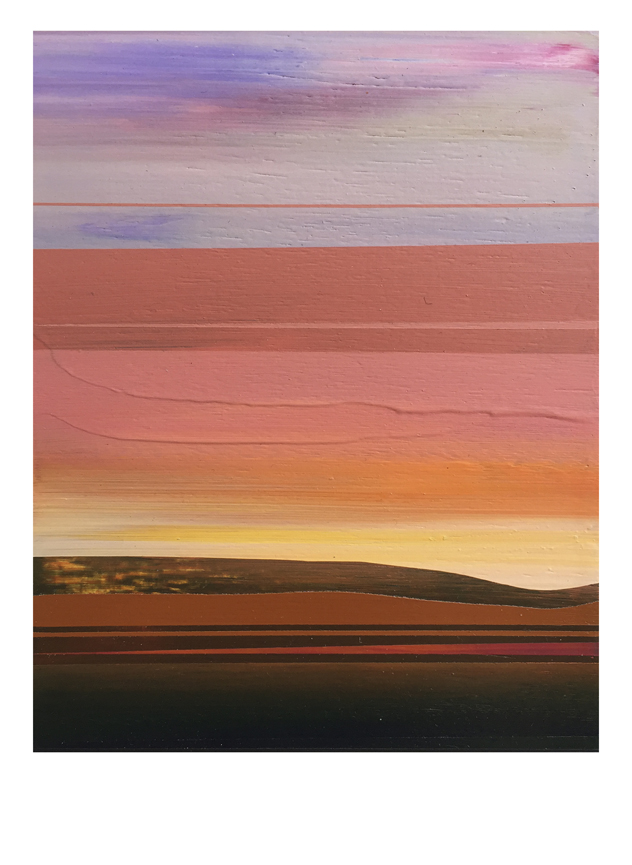
{Praxis 5}
As his creative point of view continues to develop in tandem with his artistic maturity and ambition, his latest show is pushing the Sacramento art community to recognize and embrace the beauty that can be found within abstraction.
“The work is meant to give a feeling of exhale to the viewer,” he explains. “We’re constantly surrounded by a world made of man-made things so [this show is about] when you get back to nature; it’s why I started painting like this. I paint what I like to see or feel, and so these vast colorscapes lend themselves to my life.”
His bold, nonfigurative compositions are imbued with explosions of color that are able to convey passion and excitement while, at the same time, evoking serenity and tranquility. And although this latest exhibition is instantly recognizable as a Crandall-Bear show, the artist says that he is taking his signature theme and breathing new life into the canvas.
“These pieces are still heavily layered and detailed, yet a sense of calm can be found as variations in dense tones give way to luminous neutrals,” he says.
Check out Latitudes which runs now through July 2, 2015, at Elliott Fouts Gallery, located at 1831 P Street in Sacramento. A reception for the show will be held on Saturday, June 13, from 6 to 9 p.m. For gallery hours, go to Efgallery.com. If you’d like to learn more about Micah Crandall-Bear and peruse his artwork before you go see it in person, go to Micahcrandallbear.com.
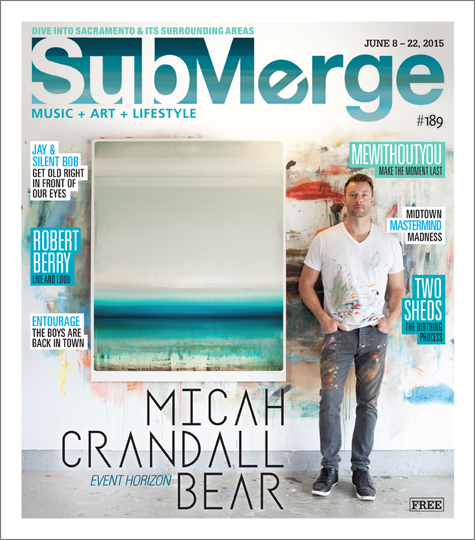
Talent and Connections brought Once an Empire Together, and to Cesar Chavez Park
In the era of “pay to play,” hounding venue owners and promoters for a shot at a 15-minute slot on a bill, slogging up and down the streets of Sacramento flyering the hell out of the grid, not to mention the near-constant act of pestering—um, convincing— friends and family to come to your shows, new bands have a pretty tough time breaking into the local music scene. It’s a grind; it’s the art of the hustle.
So, when a new band is still attempting to ascend the ranks in the local music scene and it manages to pull of one off the biggest coups in the Sacramento music scene by snagging a much-coveted spot on the 2014 Concerts in the Park roster, it’s kind of a big deal.
Such was the case for Once an Empire—with a growing fan base and another invitation to play their brand of alternative rock to the heaving mass of music lovers at Cesar Chavez Park this summer, the fledgling quintet is looking to solidify its place in the local musical lexicon.
“We got kind of lucky because we got scouted on Halloween night out at Powerhouse,” Empire’s lead singer, Melissa McGregor, explains. “We were dressed as the Channel 4 news team [of the film Anchorman] and it was a riot. Everybody loved it, and so that got us a lot of attention and the right people were there and saw us play, and when they told us they wanted us to come play [at Concerts in the Park] we were just like, ‘Wait, what…like, really, really?’”
As one of the latest bands to emerge out of the many jam sessions that echo throughout garages and basements all around the valley, Once an Empire is a product of the wellspring of musicians in this town. Web-like interconnections led guitarist Jess Hudson to regroup with an old friend from high school who ran a small studio space perfect for jamming.
“I had really started paying attention to music again after having two small children, and I really wanted to play so I followed through with it,” Hudson explains. “He ran a little studio where he recorded bands, so that gave us a really easy place to set up. Initially, we were jamming with another buddy, who didn’t work out, but we didn’t know who would play what… So long story short, we realized, Mike, my friend couldn’t cut it on drums and he’d rather play guitar anyway, so he knew about Steve…and when Steve showed up it kind of immediately sounded like something, [but] we were just going to jam and drink beer.”
“Was it like ‘Dad League,’ or whatever,” drummer Steve Samudio questions in with a chuckle.
“Yeah, ‘Dad League’ or ‘Beer League,’” Hudson confirms with a grin. “So, when Steve showed up it started sounding like something. We started recording ourselves because we had access and, when we heard it [played] back, sparks started flying and we thought we could really do something with this [band] and that was probably the beginning of it. Steve had a friend who we called in to play bass and, although Melissa knew of our band early on, eight months later she came on.”
What began in 2011 as Hudson’s desire to get back into playing music upon his return to Sacramento from Montana with his wife, along with two small daughters in tow, ultimately turned from a jam session with friends into Empire’s current lineup: Levi Vigna joined him on guitar, JR Wooten stepped up to play bass and Samudio joined the group to carry the beat on drums. It wasn’t until a random demo came through during their search for a frontman that inspired the group’s decision to bring McGregor on to handle the vocals.
“We were very specifically looking for a male singer…” Hudson explains. “We had a whole bunch of guys send in demos for two or three months just so that we wouldn’t have to bring every person in to try them out, so we would make them record over our demos and send it back. This guy sends one back we couldn’t tell if it was a female or male voice at first, I knew from emailing that I thought it was a guy, but it sounded like a female voice.”
And the idea was born—talk about girl power!

“Although it was a really different take on our music, which was initially heavier than it is now, something led to [Melissa] going in and recording,” Hudson continues. “Once we heard it we asked her then to record to our hardest rock song…and she killed it. So at that point yeah, we were like, hey let’s go for it.”
“Prove yourself,” McGregor fills in with a wry grin.
And that she did. While McGregor admits this is the first band she has ever been in, let alone fronted, she is the lyrical powerhouse in the band—she writes all of the lyrics and harmonies.
“As far as the music goes, it’s a fully collaborative thing,” McGregor explains. “Jess comes in with a lot of ideas—he is constantly writing new stuff, and he brings that to us and we collaborate.”
Now, two EPs later, the band has packed shows and fans who even approach them during interviews in coffee shops—yes, one such fan couldn’t help but approach them to express her avid appreciation for their music after having seen them perform at a recent gig.
“I’m sorry to interrupt you, but I saw you at Pizza Rock on Valentine’s Day,” gushes Elena Cordova. “That was awesome…that was the best part of my day.”
Their music is a combination of catchy, undulating melodies set over an abundant supply of crunchy, distorted rhythms. Empire first entered the scene with its 2013 offering, 11 Minutes After Sunrise and almost immediately after its release began amassing a stockpile of songs that ultimately evolved into a second album.
Recording the band’s second EP, Changing Shapes, produced, recorded, mixed and mastered by Sean Stack at Fat Cat Recording, was an experience that its members cite as essential to putting out a collection of songs they could be proud of. Stack, the ultimate task master and one who practices the utmost professionalism in the booth—he is a musician himself, after all—was essential to the band staying on track, according to Hudson.
“Sean is just the kind of guy who sits there and gives you his full attention,” McGregor explains. “He’s treating your art as if it’s very important to him and that’s the coolest thing about working with Sean. You get his full attention and he works so hard and he’s such a talented guy. That’s why we like to give him a lot of leeway with co-producing and getting his ideas into it because he’s just so good at what he does.”
The fivesome is anticipating a healthy turnout when they unleash the beast that is their second album at the record release party on March 14, 2015, at Powerhouse Pub in Folsom. They’re also gearing up to expand on their growing catalog of music. Not too shabby for a new band on the block.
“We have enough material for a whole new album right now,” Samudio says. “Some songs are better than others, but they’re there.”
With a healthy selection of material, a dynamic that includes bandmates who actually enjoy playing and recording together, Once an Empire looks poised to take on, well, the Sacramento music empire.
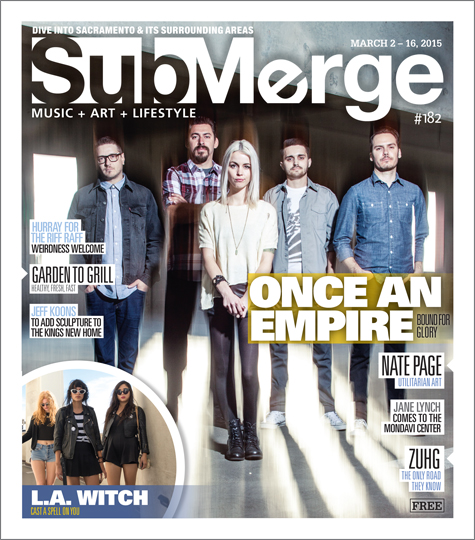
For more info, visit Onceanempire.com





